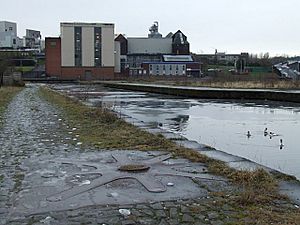Port Dundas facts for kids
Port Dundas is an area in Glasgow, Scotland. It is about 1.6 kilometers (1 mile) north of the city center. This area is located north of Cowcaddens and west of Sighthill. Hamiltonhill and Possilpark are to its northwest.
Contents
History of Port Dundas
The Port Dundas area was created between 1786 and 1790. It was named after Sir Lawrence Dundas, 1st Baronet, who helped fund the Forth and Clyde Canal Company. Port Dundas became the end point of a branch of the Forth and Clyde Canal in Glasgow. This canal also connected to the nearby Monkland Canal.
During the 1800s, Port Dundas grew into a busy industrial hub. Many different businesses operated here. There were textile factories, chemical plants, and large grain storage buildings. Distilleries, glass factories, iron foundries, and power stations also worked in the area. In 1859, a very tall brick chimney was built for F. Townsend. It was 138 meters (454 feet) high, making it the tallest chimney in the world at that time. Its base was about 9.7 meters (32 feet) wide.
Pinkston Power Station
In 1900, the Pinkston Power Station was built in Port Dundas. This power station used coal to make electricity. It powered the Glasgow Corporation Tramways, which were electric streetcars. Glasgow decided to electrify its streetcar system by 1901 for a big exhibition.
A very large cooling tower was added to the power station in 1954. It was the biggest in Europe at the time. The power station stopped working in the 1960s. It was taken down in the early 1980s.
Changes and New Life for the Area
Over the 1900s, many industries in Port Dundas closed down. The Monkland Canal was closed for boats in 1952. The Forth and Clyde Canal closed in 1963. Charles Tennant's chemical factory, once the world's largest, closed in 1964.
In the 1970s, the M8 motorway was built just south of Port Dundas. It went over where the Monkland Canal used to be. This made it harder to reach the canal area.
However, in the early 2000s, the Forth and Clyde Canal was reopened for fun activities. The canal and old warehouses in Port Dundas were also fixed up. Many of the old buildings were turned into modern apartments.
Port Dundas Grain Distillery
Port Dundas was home to a very large Scotch Grain distillery. This distillery made 39 million liters of alcohol each year. It was built on a 8.5-hectare (21-acre) site. It closed in 2010.
Originally, there were two distilleries here. The first started in 1811. The second began two years later. In 1845, both distilleries added Coffey Stills. These machines helped them make Grain whisky.
The two distilleries joined together in the 1860s. They later became part of the Distillers Company in 1877. Fires destroyed them in 1903 and again in 1916. But they were rebuilt both times. The distillery was closed during World War II.
In the 1970s, the distillery was made much more modern. New buildings were added for grain, alcohol storage, and boilers.
The Port Dundas Grain Distillery and the nearby Dundashill Cooperage were owned by Diageo. The cooperage, which made large wooden barrels, dates back to 1770. The distillery's tall chimney was a major landmark in North Glasgow.
The distillery made Grain whisky for many famous blended whiskies. These included Johnnie Walker, J&B, Bell's, Black & White, Vat 69, Haig, and White Horse.
In 2009, Diageo announced the Port Dundas distillery would close. All production moved to other distilleries in Scotland.
Images for kids




